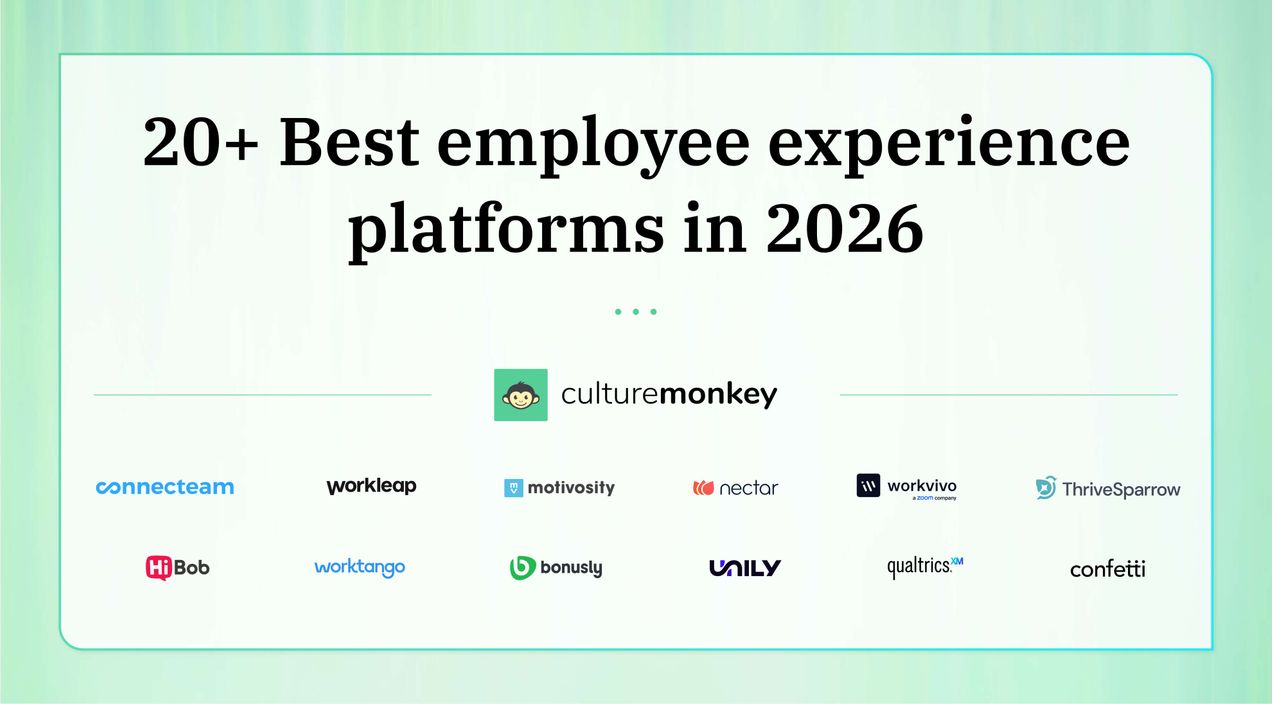Employee grievances: How to handle them in the workplace as a leader in 2024

Navigating employee grievances is a vital aspect of leadership. When employees voice concerns about work conditions, interpersonal conflicts, or organizational policies, leaders must respond effectively to maintain a healthy work environment.
Employee complaints are inevitable in the workplace and data shows that 1/3 of U.S. workers believe that workplace conflict will increase over the next 12 months. This makes it crucial to have policies and procedures in place to handle them in a timely and professional manner.
Mishandling these issues can lead to decreased morale, reduced productivity, and even higher turnover rates. By fostering a culture of open communication and implementing best practices for grievance handling, leaders can ensure employee satisfaction, bolster trust within the team, and create a more harmonious and productive workplace.
In this blog, we provide a clear roadmap for leaders in 2024, detailing how to address and resolve workplace grievances
What are employee grievances?

Employee grievance refers to the discontentment of an employee with the corporate and its management. They are formal complaints raised by employees concerning their work environment, conditions, or relationships within the organization. These grievances can stem from a variety of sources, including perceived unfair treatment, inadequate working conditions, conflicts with colleagues or supervisors, or dissatisfaction with company policies and practices.
When employees feel that their concerns are not being heard or addressed, they may resort to filing formal grievances to seek resolution. The nature of grievances can vary widely, encompassing issues such as discrimination, harassment, wage disputes, job security, and violations of labor laws.
Addressing them promptly and fairly is crucial for maintaining a positive workplace atmosphere. Unresolved grievances can lead to increased stress, decreased productivity, and higher employee turnover rates.
Effective grievance handling involves open communication, thorough investigation, and a commitment to finding equitable solutions, ensuring that employees feel valued and heard within the organization.
Why is it important to address employee grievances?

Addressing employee grievances is crucial for maintaining a healthy and productive work environment. When grievances are promptly and effectively managed, it fosters a culture of trust and respect within the organization.
Employees feel valued and heard, which can significantly boost morale and job satisfaction. This, in turn, enhances overall productivity and reduces turnover rates, saving the organization time and resources associated with hiring and training new staff.
Moreover, addressing grievances can prevent small issues from escalating into larger conflicts that might disrupt workplace harmony. It demonstrates the organization's commitment to fairness and transparency, reinforcing ethical standards and legal compliance.
By resolving grievances, management can also gain insights into potential systemic issues that may require broader organizational changes.
Ultimately, a proactive approach to handling grievances contributes to a more positive organizational culture, where employees are more engaged, motivated, and committed to their roles and the company’s success.
What is employee grievance handling in HRM?

Employee grievance handling in Human Resource Management (HRM) is the process of addressing and resolving complaints or concerns raised by employees within an organization.
This aspect of HRM focuses on creating a structured approach to manage grievances, ensuring that employees have a clear and fair pathway to express their issues and seek resolution.
The process typically involves several stages, including the identification of grievances, documentation, investigation, and resolution. A formal grievance process is a written submission outlining employee concerns that should be treated seriously and promptly, initiating the employer's obligation to follow a fair grievance procedure.
Effective grievance handling is essential for maintaining a positive work environment and fostering trust between employees and management. HR professionals play a key role in this process, acting as intermediaries who facilitate open communication and ensure that all grievances are taken seriously.
They work to understand the root causes of issues, conduct thorough investigations, and implement fair solutions. This may involve mediation, policy adjustments, or disciplinary actions when necessary. Ultimately, effective grievance handling helps to enhance employee satisfaction, reduce workplace conflicts, and promote a culture of transparency and accountability within the organization.
What are the types of employee grievances in the workplace?

Employee grievances in the workplace can vary widely, but they generally fall into several key categories:
- Work environment: Issues related to the physical or psychological aspects of the workplace, such as poor working conditions, inadequate equipment, or unsafe environments.
- Compensation and benefits: Concerns about salaries, wages, bonuses, overtime pay, benefits, or discrepancies in pay.
- Workload and job assignments: Complaints about excessive workloads, unfair job assignments, and lack of resources to fulfill job responsibilities effectively, or unreasonable deadlines.
- Management and leadership: Issues with management practices, such as unfair treatment, lack of support, poor communication, or perceived favoritism and bias.
- Interpersonal conflicts: Conflicts or issues with colleagues, such as harassment, discrimination, bullying, or lack of teamwork. Data shows that the overwhelming majority of grievances raised are around bullying and harassment, a staggering 67%.
- Career development: Grievances about limited opportunities for advancement, lack of training, or unfair performance evaluations.
- Policies and procedures: Discontent with company policies, procedures, or changes in work rules that employees perceive as unfair or poorly communicated.
- Work-life balance: Issues arising from inflexible working hours, lack of support for personal or family commitments, or inadequate leave policies.
What are the causes of employee grievances?

Employee grievances can arise from a variety of sources within the workplace. Understanding these causes is essential for addressing and mitigating issues before they escalate. Here are some common causes of employee grievances:
- Unfair treatment: Perceived or actual favoritism, bias, or discrimination in promotions, assignments, or evaluations can lead to grievances. Employees may file a formal complaint when they perceive favoritism, bias, or discrimination. Employees expect fair and equal treatment in all aspects of their employment.
- Poor working conditions: Issues related to the physical work environment, such as inadequate facilities, unsafe conditions, excessive noise, or lack of proper equipment, can cause dissatisfaction.
- Conflict with colleagues or supervisors: Interpersonal conflicts, bullying, harassment, or poor management practices can create a hostile work environment, prompting employees to file grievances.
- Inadequate compensation and benefits: Discontent with salary, lack of raises, insufficient benefits, or perceived inequities in pay can lead to grievances. Employees expect their compensation to reflect their contributions and industry standards.
- Job insecurity: Concerns about job stability, such as frequent layoffs, lack of clear career progression, or fear of unjust termination, can cause anxiety and grievances.
- Workload and work-life balance: Excessive workload, unrealistic deadlines, and lack of flexibility can lead to stress and burnout. Employees value a balance between work and personal life.
- Lack of recognition: Feeling undervalued or unappreciated for their efforts and contributions can cause employees to feel demotivated and disgruntled.
- Policy and procedure issues: Unclear, inconsistent, or unfair company policies and procedures can lead to misunderstandings and grievances. Employees expect transparency and consistency in organizational practices.
Creating a written grievance procedure policy

Creating a workplace grievance policy involves several key steps to ensure it is effective, fair, and legally compliant. Here’s a step-by-step guide:
- Assess needs and legal requirements: Review current grievance handling practices to identify gaps and consult legal requirements to ensure compliance with local labor laws.
- Define objectives and scope: Set clear objectives for the policy, such as resolving disputes fairly, and define the scope, including the types of grievances covered and applicable employees.
- Draft the policy: Write an introduction explaining the policy’s purpose, define what constitutes a grievance, and provide examples. The policy should outline a formal, written grievance procedure that is shared with all employees.
- Establish roles and responsibilities: Designate personnel responsible for handling grievances and provide training for those involved in the grievance process.
- Communicate the policy: Distribute the policy to all employees through various channels and ensure the policy is easily accessible.
- Implement the policy: Put grievance handling procedures into practice and monitor compliance to ensure the policy is followed consistently.
- Review and update the policy: Gather feedback from employees and managers on the policy’s effectiveness and revise the policy as needed to address any issues or changes.
- Document and record: Maintain detailed records of grievances, investigations, and resolutions and review records periodically to identify and address recurring issues.
7 Best practices for dealing with employee grievances

Handling employee grievances effectively requires a structured approach and commitment to fairness. Here are seven best practices for dealing with employee grievances:
- Establish clear procedures: Develop and communicate a formal grievance procedure that outlines the steps employees should follow to raise and resolve their concerns. Ensure that employees are aware of these procedures and understand how to access them.
- Create a safe reporting environment: Encourage open communication by fostering a culture where employees feel safe to voice their concerns without fear of retaliation. Ensure confidentiality to protect employees who raise grievances.
- Act promptly: Address grievances as soon as they are raised. Delaying action can exacerbate issues and lead to increased frustration. Timely resolution demonstrates a commitment to employee well-being and helps prevent escalation.
- Listen actively: Provide a platform for employees to express their concerns fully. Listen carefully and empathetically, and avoid making assumptions. Understanding the root cause of the grievance is crucial for finding effective solutions.
- Investigate thoroughly: Conduct a fair and impartial investigation into the grievance. Conducting a grievance hearing is crucial to formally discuss and address the concerns raised by an employee. Gather relevant information, interview involved parties, and review any documentation. Ensure that the investigation is comprehensive and objective.
- Implement fair solutions: Based on the findings of the investigation, take appropriate and equitable actions to resolve the grievance. Communicate the resolution to the affected parties and ensure that any necessary changes or corrective measures are implemented.
- Review and improve: Regularly review grievance handling processes and outcomes to identify areas for improvement. Use feedback from grievances to enhance workplace policies, practices, and overall employee satisfaction.
5 Employee grievances examples at work

Here are five examples of employee grievances that might arise in the workplace:
1. Discrimination
An employee feels they are being unfairly treated based on race, gender, age, religion, or other protected characteristics. For instance, a female employee may believe she is being passed over for promotions in favor of male colleagues, despite having equal qualifications and performance.
2. Harassment
An employee experiences unwanted or inappropriate behavior from a colleague or supervisor, such as persistent bullying, sexual harassment, or verbal abuse. For example, an employee might file a grievance due to repeated, offensive comments from a coworker.
3. Unfair pay
An employee discovers that their compensation is not aligned with industry standards or is less than that of peers with similar roles and responsibilities. For instance, an employee may feel aggrieved if they find out that a colleague in a similar position is earning more despite having similar or less experience.
4. Unsafe working conditions
An employee raises concerns about hazards in the workplace that pose health and safety risks. For example, an employee might file a grievance if they notice that safety equipment is malfunctioning or that the workplace lacks proper ventilation, leading to a hazardous environment.
5. Poor management practices
An employee is dissatisfied with the management style or practices of their supervisor, such as favoritism, lack of support, or inconsistent feedback. For instance, an employee might feel aggrieved if their manager consistently overlooks their contributions while favoring other team members for recognition and rewards.
How to handle employee grievances as an HR?

Handling employee grievances as an HR professional involves a structured and empathetic approach to ensure fair and effective resolution. Begin by listening carefully to the employee’s concerns, offering a safe and confidential space for them to express their issues. Document the grievance thoroughly, noting key details and any supporting evidence.
Next, investigate the grievance impartially by gathering relevant information from all parties involved. This may include interviewing witnesses, reviewing documents, and assessing the context. Maintain transparency throughout the investigation to build trust and ensure that the process is fair.
If the employee is not satisfied with the outcome of the internal grievance and appeal procedures, they may escalate their problem to an employment tribunal.
Once the investigation is complete, analyze the findings and determine an appropriate resolution. Communicate the outcome to the employee and any necessary parties, detailing the steps taken and the decisions made.
Finally, follow up to ensure the resolution is effective and to prevent recurrence. Continuous feedback and review of the grievance process can help improve future handling and maintain a positive work environment.
Significance of anonymous employee feedback mechanisms in resolving employee grievances at work
Anonymous employee feedback mechanisms play a crucial role in resolving grievances within the workplace by providing a safe and confidential way for employees to express their concerns.
These mechanisms, such as anonymous surveys, suggestion boxes, or dedicated hotlines, allow employees to report issues without the fear of retaliation or negative repercussions.
This anonymity encourages more honest and open communication, which is essential for identifying and addressing underlying problems that might otherwise go unreported.
By utilizing anonymous feedback, organizations can gain valuable insights into workplace issues such as management practices, working conditions, or interpersonal conflicts. This information can help HR departments and leadership understand employee grievances more comprehensively and implement targeted solutions. Moreover, the use of anonymous feedback can highlight systemic issues that may require broader organizational changes.
The significance of anonymous feedback lies in its ability to foster a culture of trust and transparency. When employees feel that their concerns are taken seriously and addressed appropriately, it can lead to improved morale, increased engagement, and a more positive work environment.
Conclusion
Effectively managing employee grievances is essential for maintaining a healthy and productive work environment. By understanding the causes of grievances and implementing best practices for handling them, leaders can address issues promptly and fairly.
Utilizing anonymous feedback mechanisms further enhances this process by encouraging open communication and revealing underlying problems that might otherwise remain hidden.
Ultimately, a proactive and transparent approach to grievance management not only resolves individual concerns but also fosters a culture of trust and continuous improvement, benefiting both employees and the organization as a whole.
FAQs
1. What is an employee feedback survey?
An employee feedback survey is a tool used to collect employees’ opinions, concerns, and suggestions about their work environment, management, and overall job satisfaction. It includes questions about various aspects of the workplace and allows employees to provide anonymous and honest feedback. This data helps organizations identify issues, assess employee satisfaction, and make decisions to improve workplace conditions.
2. How often should employee feedback surveys be conducted?
Employee feedback surveys should be conducted regularly, such as annually or semi-annually, to effectively gauge employee sentiment and track changes over time. More frequent surveys, like quarterly pulse surveys, can provide timely insights into specific issues or recent changes. Regular surveys help maintain a continuous dialogue between employees and management, ensuring ongoing improvements and responsiveness to emerging concerns.
3. How can survey results help resolve employee grievances?
Survey results highlight recurring issues and systemic problems that might contribute to employee grievances. By analyzing feedback, HR can identify common concerns, such as poor management practices or inadequate resources, and address these issues proactively. Implementing changes based on survey data helps resolve grievances before they escalate and demonstrates the organization’s commitment to improving the work environment.
4. What should be done with the data collected from surveys?
Data collected from surveys should be carefully analyzed to identify trends and specific areas of concern. HR should prepare a detailed report summarizing the findings and propose actionable solutions. Sharing these insights with relevant stakeholders, such as management, is crucial for implementing changes. Additionally, following up with employees on how their feedback has influenced decisions helps build trust.
5. How can organizations ensure employee feedback surveys are effective?
To ensure effectiveness, surveys should be anonymous to encourage honest feedback. Questions should be clear and designed to capture meaningful insights and communicate the purpose of the survey and how the results will be used. Promptly addressing issues raised in the surveys and providing feedback on actions taken helps demonstrate responsiveness and reinforces the value of employee contributions.



